MXA’S 2014 HONDA CRF250 MOTOCROSS TEST: HONDA HAS CONFUSED US WITH A BIKE THAT DELIVERS MIXED MESSAGES
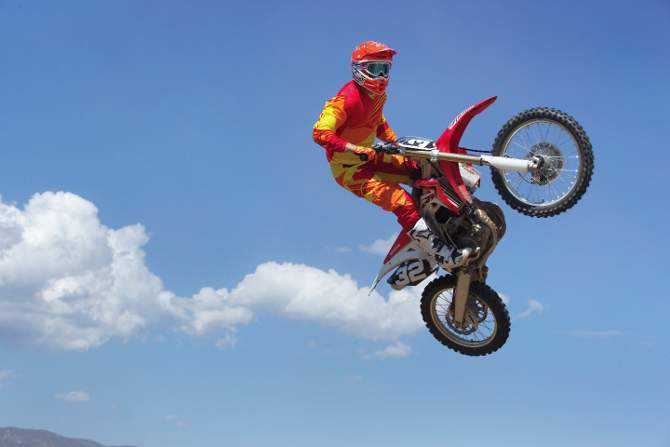
Q: FIRST AND FOREMOST, IS THE 2014 HONDA CRF250 BETTER THAN THE 2013 CRF250?
A: That is the $7599 question?because that is what a 2014 Honda CRF250 retails for. To answer the question from a performance point of view, the all-new CRF250 is marginally better than last year’s bike. Though Honda made a laundry list of changes to the CRF250, the updates are more cosmetic than qualitative. While Honda managed to improve the CRF250 in some areas, it got weaker in other areas. You’ll need to ask yourself one pointed question, and you will do yourself a disservice if you don’t answer honestly. How fast am I? If you’re a trail rider, Beginner, Novice or Vet, then the 2014 CRF250 is the bike for you. Otherwise, caveat emptor. Read more to find out why.
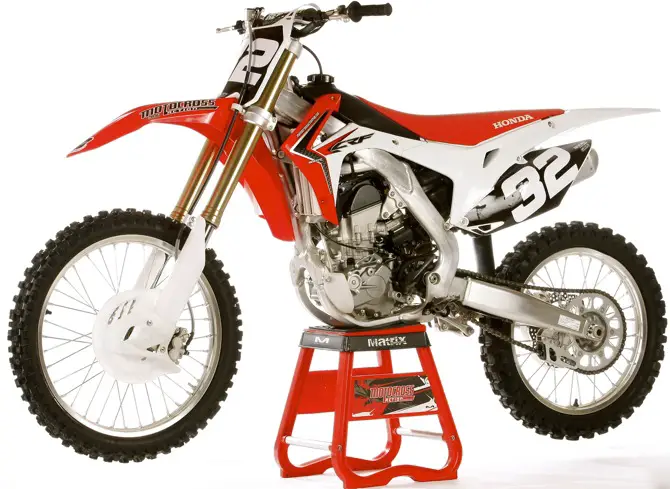
Q: HOW MANY CHANGES CAN BE FOUND ON THE 2014 CRF250?
A: Aside from the 2014 Yamaha YZ250F, the Honda CRF250 is the only other 250 four-stroke to boast a substantial number of changes.
(1) Frame. Honda focused on lowering the center of gravity to improve the handling traits of the CRF250. The main chassis spars have been moved downward by 37mm. In turn, the gas tank is closer to the ground. Given that the tank holds 1.66 gallons (up from 1.5 gallons last year), equating to roughly 10 pounds of fuel, that’s a considerable amount of weight. Although the twin spars have been lowered, the steering head tube and frame geometry remain the same as on the previous-generation CRF250. Also, the subframe has been lightened and reconfigured to accommodate dual mufflers.
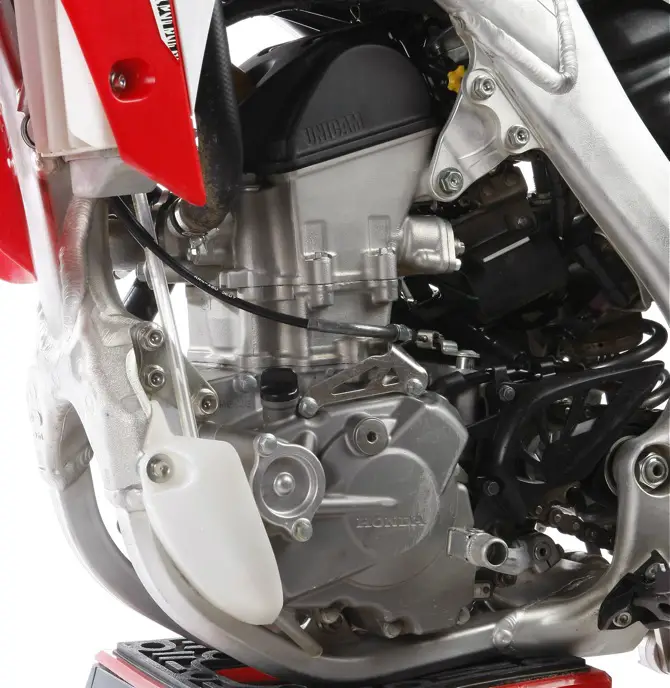
(2) Engine. The CRF250 retains the Unicam valve-and-cam system and four-valve head (with titanium intake valves and steel exhaust valves). Honda increased the compression ratio?from 13.2:1 to 13.5:1?and dutifully utilized a new forged slipper-type piston with a thinner crown for less reciprocating weight and a low-friction surface treatment to reduce friction. The combustion chamber shape has been altered for more power, and the ports were optimized for increased flow.
(3) EFI. Following in the footsteps of their factory race teams, Honda readjusted the fuel-injector nozzle for a more efficient spray into the intake port. The CRF250 also comes with what Honda’s marketing team deems Dual-Timing Programmed Fuel Injection (PGM-FI). To explain, the PGM-FI injects two charges (or one long charge with a pause in it). The first, short-duration charge is used to cool the intake valve/port area in order to increase the density of the air/fuel mixture. The second charge increases the amount of fuel directed into the combustion chamber to improve power and response. The goal of PGM-FI is to improve throttle response at partial throttle openings.
(4) Transmission. To complement the increase in power, the CRF250 has a stronger transmission. The width of each gear has been increased, making the transmission 13 percent stronger. Note that the engine width hasn’t been compromised. Honda managed to go bigger on the gears without widening the side case.
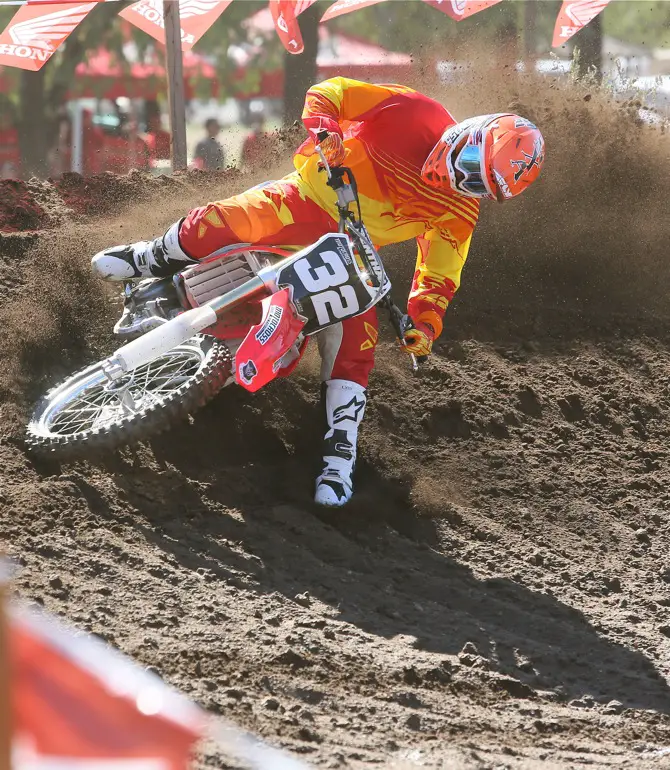
(5) Dual mufflers. Twice pipes are back on the CRF250. They first appeared on the 2006 model, and Honda stuck with their original dual-muffler idea through 2009. Then, in 2010, the red crew returned to the traditional single design. Honda’s literature states, “This dual-exhaust system allows the use of shorter mufflers that mount closer to the bike’s center of mass for a lower moment of inertia. As a result, even though the two mufflers together weigh only slightly more than a comparable single, larger muffler, in real-world terms, the net gain is a bike that’s more flickable, easier handling in the air and more responsive in corners than it would be with a conventional single muffler design.”
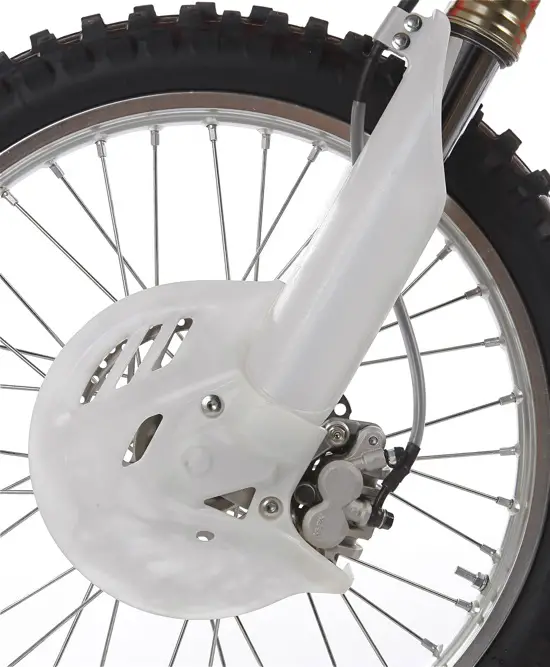
(6) Suspension. The 48mm Showa cartridge forks feature new settings. Please note, these are not the air forks from the CRF450. Honda also equipped the CRF250 with a new swingarm, linkage and Showa rear shock.
(7) Other updates. The radiators are mounted lower (20mm on the right and 18mm on the left) to help lower the bike’s center of gravity. The footpeg mounts have debris-shielding covers, and the peg mounts are 10 percent lighter. Also, the rear fender has a better lift point, and the new bodywork is shared with the 2013-2014 CRF450.
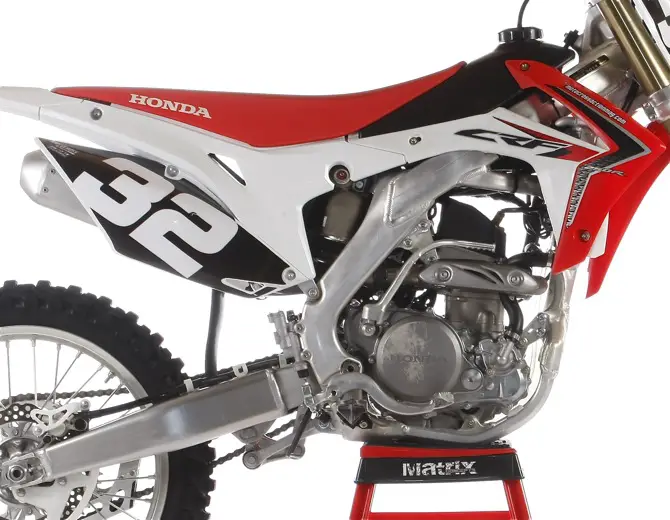
2014 Honda CRF250: Honda unveiled an all-new CRF250, hailing it as an improvement to the previous generations. Their engineers focused on the chassis, engine, suspension, transmission, exhaust and body styling.
Q: WHAT IS THE MOST IMPORTANT CHANGE MADE TO THE 2014 HONDA CRF250?
A: On paper, it appears that Honda completely redesigned the 2014 CRF250 from the ground up. That’s not the case. Honda utilized the same basic engine, frame geometry, Showa suspension components and brake package. Yes, the new CRF250 has an extensive number of updates, but these changes are deceiving. The 2014 CRF250 is eerily reminiscent of the 2013 model, only it’s disguised in new body styling and dual mufflers.
The most important changes Honda made to the CRF250 are that the engineers addressed two owner complaints.
(1) Powerband. Last year’s engine had a midrange-only spread that didn’t do anything extraordinarily well. It wasn’t fast, and it wasn’t slow. It was more middle of the road than any other 2013 250 four-stroke.
(2) Handling. Honda’s radical frame geometry was too much for many riders. The CRF250 had a tendency to oversteer and suffered from headshake at speed. A lowered center of gravity and suspension revisions were aimed at putting more weight on the front end and balancing the chassis.
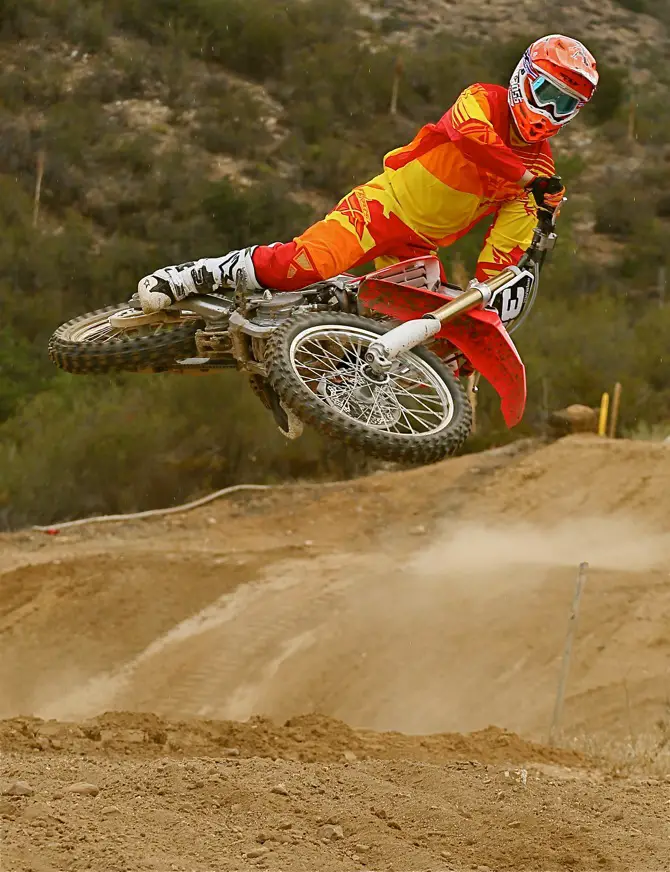
Whip it good:?A lower center of gravity brought weight down in the chassis. In turn, the already agile CRF250 feels even more svelte. It’s a bike that likes to be handled with aggression.
Q: HOW DOES THE 2014 CRF250 RUN ON THE DYNO?
A: Maximum horsepower on our 2014 CRF250 was 37.25 ponies at 11,200 rpm. Maximum torque was 19.72 foot-pounds. To compare, last year’s CRF250 powerplant produced 37.19 horsepower at 10,700 rpm and made 19.79 foot-pounds of torque. The differences are insignificant at peak; however, the dyno curve of the 2014 model shows an increase in bottom-end power from 5000 rpm to 6500 rpm. Whereas the 2013 CRF250 produced 16 horsepower at 6000 rpm, the new engine makes 17.76 ponies. That is a significant increase in throttle response and burst. By 8000 rpm, an overlay of both dyno engine graphs has them matching up almost perfectly.
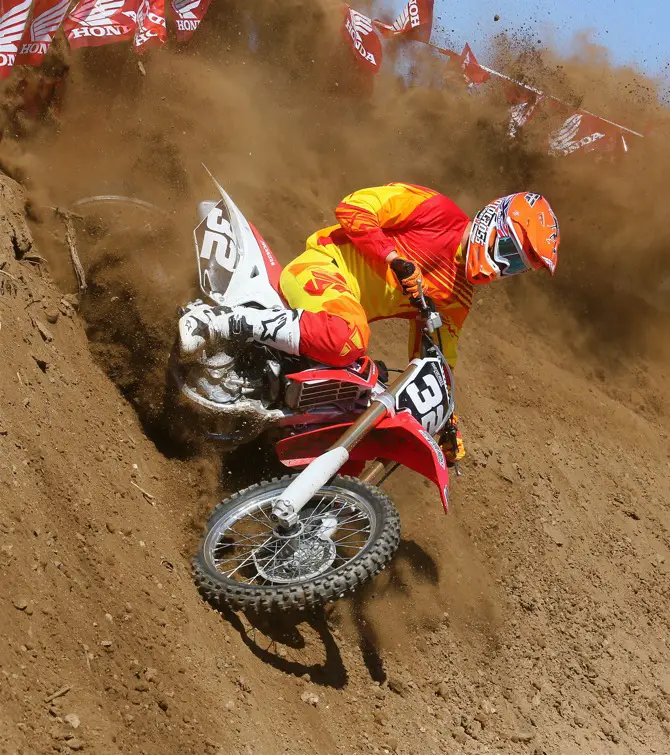
Q: HOW DOES THE 2014 HONDA CRF250 STACK UP TO THE COMPETITION ON THE DYNO?
A: Honda hasn’t made a quantum leap in horsepower?in fact, back in 2009 the Honda CRF250 was making 37 horsepower and that’s what it makes five years later. Not gaining a single horse in five years is not progress. By contrast, the 2014 KX250F, YZ250F and KTM 250SXF have surpassed the 40-horsepower barrier. That power difference is comparable to racing against a Ferrari Testarossa in a Ford Festiva.
The KTM 250SXF is king in the horsepower wars. At 42.89 horsepower, the Austrian bike makes over 1-1/2 ponies more than the Kawasaki KX250F, which climbed to 41.14 horsepower. The Yamaha YZ250F makes 40.61 horsepower. And, although unchanged, the Suzuki RM-Z250 amasses 38.01 horsepower. This means that the Honda CRF250 has the least horsepower of any engine in the class (and the 250 class is all about horsepower). Though the whining sound of the CRF250 Unicam engine on our dyno isn’t exactly a death knell, it is disconcerting.
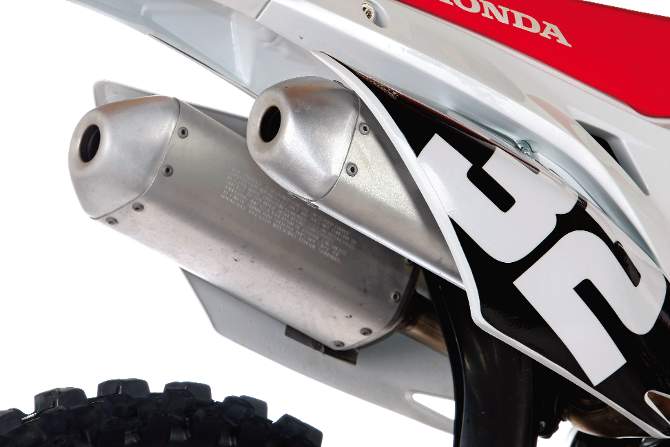
Double vision: Dual pipes are back. We still don’t know why.
Q: HOW FAST IS THE 2014 HONDA CRF250 ON THE TRACK?
A: Before we answer that question, we feel compelled to reminisce about the 2010?’13 CRF250 powerband, which we described as pleasant, smooth and manageable. The midrange-only engine lacked the pedigree that we yearned for, but was workmanlike as long as it was short-shifted.
The 2014 Unicam engine isn’t unlike last year’s engine, at least at half throttle; however, at low rpm, the revised 2014 engine shines. Apparently, Honda aimed at satiating those with a penchant for riding in the first half of the powerband (we’re talking about slower and less-experienced riders). Faster testers complained about the flat top-end surge and wanted more over-rev (areas in which the 2013 CRF250 engine was better).
Honda’s engineers admitted that they focused on bottom-end hit and better throttle response. Kudos to their engineers for taking an active approach to developing a more lively powerband, but is this engine better than last year’s powerplant? Yes, but only for slower riders?ones who aren’t going to hold it wide open and bleed it dry. Experts and Pros preferred the old engine.
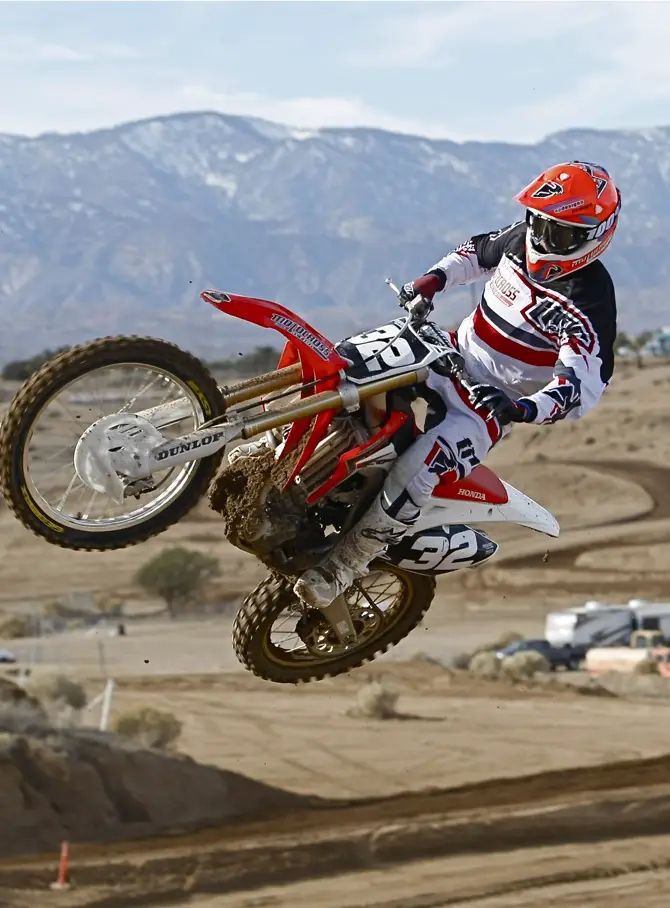
Q: HOW DOES THE 2014 HONDA CRF250 HANDLE?
A: It handles better than the 2013 model, which was superior to the 2012 version, but it still doesn’t hold a candle to the 2009 model. Lowering the center of gravity and making the front end stiffer were modest improvements, but the CRF250 still suffers from headshake and a tendency to oversteer through high-speed corners. Yet, in tight corners, the CRF250 can cut a line inside the competition (although the Suzuki RM-Z250 is also excellent at cornering). Riding the CRF250 is a give-and-take type of relationship. It struggles in certain areas but excels in others. This is another reason why the 2014 Honda CRF250, with its low-to-mid powerband, is tailored to less-skilled riders.

Grunt: The 2014 powerband has more bottom-end hit.
Q: WHAT WOULD WE DO TO IMPROVE THE 2014 HONDA CRF250?
A: It’s relatively easy to improve the CRF250 (and necessary).
(1) Steering stem. Every motocross bike has a built-in steering stabilizer. Don’t believe us? Crank down on your steering stem nut (the one underneath the top triple clamp) and turn your handlebars. You’ll notice an increased amount of drag. On the CRF250, we tighten the steering stem nut until the front end fails to flop easily from side to side. Yes, we are aware that the Honda has its proprietary HPSD damper, but we tightened the nut in addition to the stock damper.
(2) Oil height. Honda lowered the oil height in the Showa 48mm forks by 6cc for 2014. Heavier and faster riders will find relief by adding 6cc (or more) back into the fork legs. Doing so will lessen bottoming and change how quickly the forks ramp up in the stroke.
(3) Exhaust. We discovered with the latest-generation CRF450, which is also equipped with a dual-exhaust system, that most aftermarket single-sided exhausts are better. That is also the case with the 2014 CRF250. Drop the excess weight of the dual exhaust and pump up the power by going to a conventional single.
(3) Cam. When you combine a hopped-up cam with the aftermarket exhaust pipe, you can gain as much as 4 horsepower on the CRF250. The saving grace of this mod is that the CRF250’s Unicam design only requires one camshaft, which won’t make as much of a dent in the wallet as DOHC engines.
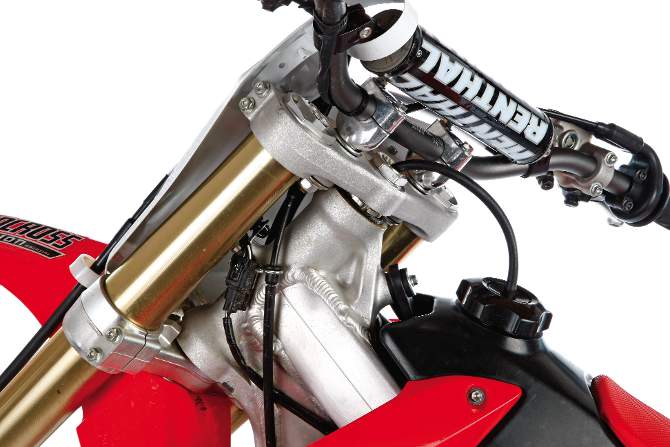
Tighten up: It’s wise to snug down the steering stem nut.
Q: WHAT DID WE HATE?
A: The hate list:
(1) Engine. Well, hate is a little extreme, but lets just say that we expected the 2014 Honda to be able to pump out enough ponies to put the hurt on a 2009 CRF250. Instead, it has a beginner-friendly powerband that faster riders found unappealing.
(2) Dual mufflers. Honda tried and failed to convince the public that twice pipes were a performance advantage back in 2006. So, why are they trying it again?
(3) Headshake. Do yourself a favor and crank down on the steering-stem nut. It’s a band-aid fix for a much bigger problem.
(4) Frame cradle. Attention future Honda owners: you’ll need to invest in a special bike stand if you want the CRF250 to sit level.

Oil stop: Faster riders should raise the oil height.
Q: WHAT DID WE LIKE?
A: The like list:
(1) Ergonomics. The handlebar/seat height/footpeg relationship is comfortable for all but the tallest and smallest riders.
(2) Center of gravity. With the lower center of gravity, the CRF250 feels extremely light and flickable.
(3) Body styling. The CRF250 has a race-inspired design and sleek body styling. It shares the same plastic as big brother.
(4) Handling. How can we like the handling but also loathe the handling? When set up properly, the CRF250 corners on a dime. Though the chassis suffers from headshake, that can be addressed with setup compromises.
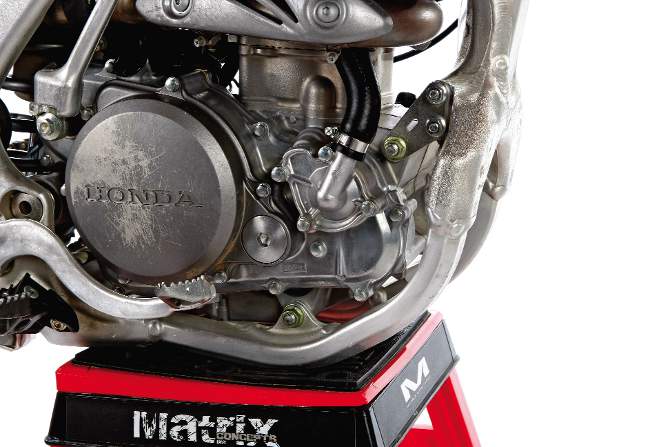
Deja vu: The CRF250 frame has different lower frame rails than the CRF450, but other than that it is the same.
Q: WHAT DO WE REALLY THINK?
A: When news broke that Honda was unveiling an all-new CRF250 for 2014, we were ecstatic. We loved the 2009 CRF250, but the bikes since then haven’t been our cup of tea. Truth be told, the 2014 CRF250 isn’t worlds apart from the 2013 offering. We wish that Honda’s engineers had dreamed as big as we had. As its sits, the 2014 CRF250 is an excellent bike for Vets, Novices and Beginners. Faster riders will need big budgets to find happiness.
MXA’S 2014 HONDA CRF250 SETUP SPECS
Are you looking to get the 2014 Honda CRF250 suspension set up? Use these specs as a basis and adjust accordingly.
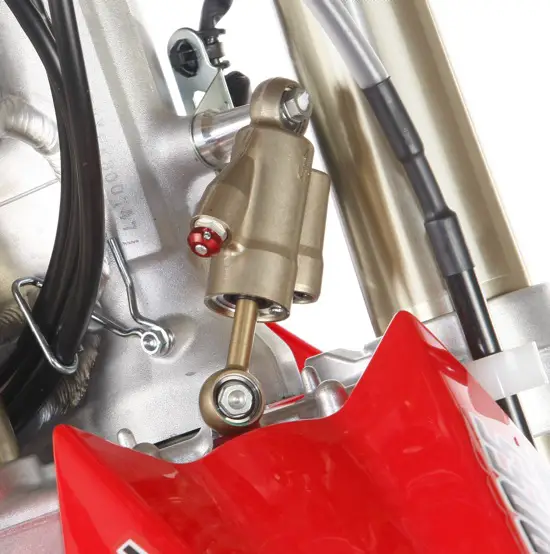
SHOWA 48MM FORK SETTINGS
Honda upped the spring rates on the 2013 CRF250 to 0.46 kg/mm and used larger pistons. These changes made a noticeable difference in the handling. Unfortunately, they removed 6cc of oil out of each leg, which caused heavier and faster riders to quickly blow through the stroke. We added oil and went in on compression, which alleviated the issue. In certain situations and track conditions (overly dry or wet dirt), the front end knifes at turn in, straightens out, and knifes again at the exit of corners. Here are several problem-solving tips.
(1) Sag. The CRF250 is very touchy when it comes to race sag. We’ve found that 104mm is a good place to start, but more sag might be necessary.
(2) Fork height. Even if you don’t notice that the front end oversteers, you’re probably aware of the headshake issues the CRF250 has at speed. Lower the fork legs until they are flush with the triple clamps.
(3) HPSD. There’s a steering damper on the triple clamps for a reason. Crank the clicker in until straight-line stability is improved. Also, don’t be afraid to tighten the steering-stem nut under the top triple clamp to reduce slack.
(4) Front tire. Trade the stock MX51FA for a terrain-specific tire like an MX31 or Bridgestone 403.
For hardcore racing, these are MXA’s recommended 2014 Honda CRF250 fork settings (when changed, stock settings are in parentheses):
Spring rate: 0.46 kg/mm
Oil quantity: 367cc (357cc)
Compression: 3 clicks out (6 clicks out)
Rebound: 9 clicks out (11 clicks out)
HPSD: 7 clicks out (9 clicks out)
Fork-leg height: Flush with top clamp

SHOWA PRO-LINK SHOCK SETTINGS
Here is what the MXA wrecking crew ran in its 2014 CRF250 (when changed, stock settings are in parentheses):
Spring rate: 5.3 kg/mm
Race sag: 104mm
Hi-compression: 1 turn out (1-1/4 turns out)
Lo-compression: 6 clicks out (8 clicks out)
Rebound: 9 clicks out (11 clicks out)
Notes: The shock is very sensitive to high-speed compression. Heavier riders should go in 1/4 turn on the high-speed compression and set the sag at 100mm.



Comments are closed.